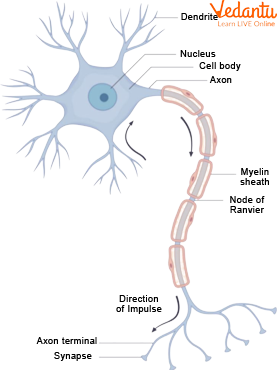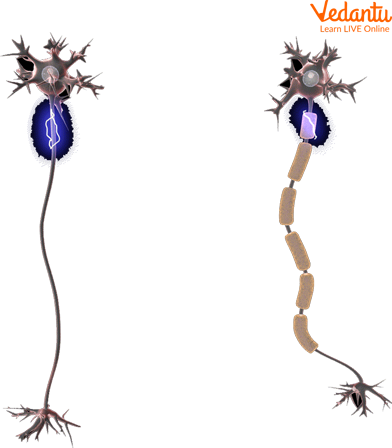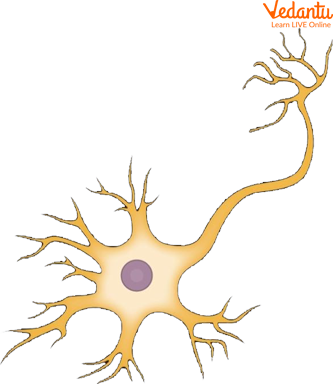




An Overview of Different Functions of Neurons
Have you ever wondered how you move your hands away from any stimulus that can be potentially harmful to you suddenly without any conscious effort? The answer is with the help of your nerves and nervous system. Your nervous system is carrying out a multitude of functions with the highest precision and accuracy and efficiency. The nervous system is the system that controls signalling, actions and reactions from the brain to all the body parts and vice versa. Now the question arises is what are neurons? Let’s dive in and see in the detail What are neurons, its structure, neuron diagram, types and Nerve cell functions

Structure of a Nerve Cell
Structure of Nerve Cell
The fundamental unit of an organism's nervous system is a nerve cell or neuron. The neurons are those specialized cells that can transmit electrical or chemical signals throughout the body. As can be seen in the above neuron diagram, the neuron comprises various parts. The structure of nerve cells or neurons varies depending upon the functions it performs and the location of their presence. Now the question arises: What function do nerve cells perform? The functioning of the nervous system is vital for the control, coordination, and balance of one's body. The smallest unit, i.e. nerve cells or neurons, all work together in a coordinated manner to carry out the above functions.
Parts of Nerve Cells
A nerve cell comprises the following parts - a cell body, dendrites, and axon.
Cell Body
The cell body has a nucleus, endoplasmic reticulum, Golgi bodies, and some granular bodies called Nissl's granules.
Dendrites
Dendrites are branching units growing out of the cell body, which usually transmit and take an impulse from the target organ/cell/tissue.
Axon
Axon is the tubular structure that carries the impulse and passes it on to the next neuron.
Axons are of Two Types:
Myelinated - are the axons enveloped by Schwann cells which form a myelin sheath around the axon. The gap between two consecutive myelin sheaths is known as the nodes of Ranvier.
Non-Myelinated - are the axons that don't possess Schwann cells and do not have myelin sheath around them.

Myelinated and Unmyelinated Axons
Types of Neurons
There are different types of neurons classified based on locations of conduction and transmission point of the stimulus:
Sensory Neurons
These neurons carry signals from the external environment and relay them to the brain and the spinal cord.
Motor Neurons
These are the most common neurons that relay information from the brain to the body's muscles.
Interneurons
These neurons connect the motor and sensory nerves and help to signal between nearby neurons.
Classification of Neurons Based on the Number of Dendrites and Axons
Neurons on the bases of axons and dendrites are further classified into three types:
Multipolar - These neurons have a single axon and two or more dendrites.

Multipolar Neuron
Bipolar - These neurons have a single axon and single dendrite: for example - the retina of the eye.

Bipolar Neuron
Unipolar - These neurons only consist of the cell body, and a single axon is usually present during embryonic stages.

Unipolar Neuron
Master Coordinator of Human Body
For humans to function, every organ in each body system must cooperate with every other organ in that system and with every other body system. Each biological system is coordinated by the nervous system both inside that system and with other systems. The neurological system regulates all actions and sensations as well as all thoughts, feelings, and memories. The nervous system monitors changes or stimuli, stores information, and/or triggers response impulses throughout impacted bodily systems for action and sensation, emotion, thought, and memory since situations inside and outside the body are always changing.
Summary
The functioning of neurons is more unique than any other cell in our body. They are self-excited, making them more adapted to have a specialized role in the conduction and transmission of impulses, to and from the target organ. The neurons, thus, form the structurally essential practical unit of the sensory system sending and getting impulses to and from different parts of the body to the nervous or sensory system. This article was all about what function does a nerve cell perform, the function of neurons, what are neurons and the structure of nerve cell.
FAQs on What Function So Nerve Cells Perform?
1. What is the primary function of a nerve cell?
The primary function of a nerve cell, or neuron, is to transmit signals throughout the body. These signals can be electrical (nerve impulses) or chemical. Nerve cells are responsible for receiving sensory information from the external world, processing that information, and sending commands to muscles and glands, thereby controlling all bodily actions and reactions.
2. What are the main parts of a nerve cell and what does each part do?
A typical nerve cell is composed of three main parts, each with a specific function:
- Cell Body (Soma): This is the core of the neuron, containing the nucleus and other organelles. It maintains the cell's health and processes signals.
- Dendrites: These are short, branch-like extensions that receive signals from other neurons and transmit them towards the cell body.
- Axon: This is a long, slender projection that carries nerve impulses away from the cell body to other neurons, muscles, or glands.
3. What are the different types of nerve cells based on their function?
Nerve cells are classified into three main types based on the direction they transmit signals:
- Sensory Neurons: These carry signals from sensory organs (like skin, eyes, and ears) to the central nervous system (the brain and spinal cord).
- Motor Neurons: These carry signals from the central nervous system to the muscles and glands, instructing them to act.
- Interneurons: Found exclusively within the central nervous system, these neurons connect sensory and motor neurons, enabling complex processing and reflexes.
4. How does a nerve cell transmit a signal to another cell?
A nerve cell transmits a signal using a two-step process. First, an electrical signal called an action potential travels down the length of the axon. When this impulse reaches the end of the axon, it triggers the release of chemical messengers called neurotransmitters into a tiny gap known as the synapse. These neurotransmitters then bind to the dendrites of the next cell, either exciting it to continue the signal or inhibiting it.
5. What is the important difference between a nerve cell (neuron) and a nerve?
A common point of confusion is the difference between a neuron and a nerve. A nerve cell (neuron) is a single, individual cell that transmits signals. A nerve, on the other hand, is a large bundle of axons from many different neurons, all wrapped together in a protective sheath. Think of a neuron as a single wire and a nerve as a thick cable containing thousands of those wires.
6. How are nerve cells involved in a reflex action, like pulling your hand from a hot surface?
In a reflex action, nerve cells create a rapid, automatic response pathway called a reflex arc. When you touch a hot surface, sensory neurons in your skin send an urgent signal to the spinal cord. Here, an interneuron immediately relays this signal to a motor neuron, which instructs the muscles in your arm to contract, pulling your hand away. This happens before the signal even reaches the brain, ensuring a quick reaction to prevent injury.
7. Why are some nerve fibres covered in a myelin sheath?
The myelin sheath is a fatty, insulating layer that covers the axons of many neurons. Its primary function is to dramatically increase the speed at which electrical impulses travel along the axon. In myelinated fibres, the impulse 'jumps' between gaps in the sheath (called Nodes of Ranvier), a process called saltatory conduction. This allows for much faster communication, which is crucial for functions like muscle movement and sharp sensory perception.
8. What is nerve tissue and what are its main functions?
Nerve tissue is one of the four main types of body tissue, composed primarily of neurons and supporting glial cells. Its main functions are to receive stimuli from both inside and outside the body, transmit information quickly across long distances, and process information to coordinate and control all bodily activities, forming the basis of the nervous system.









